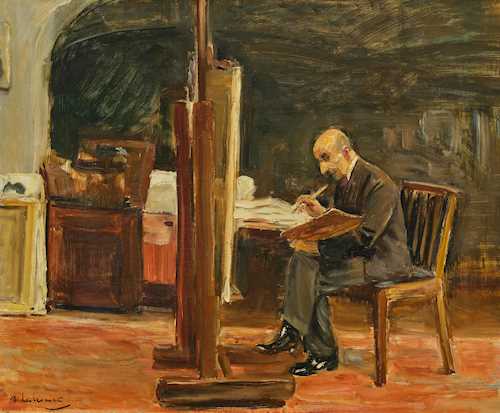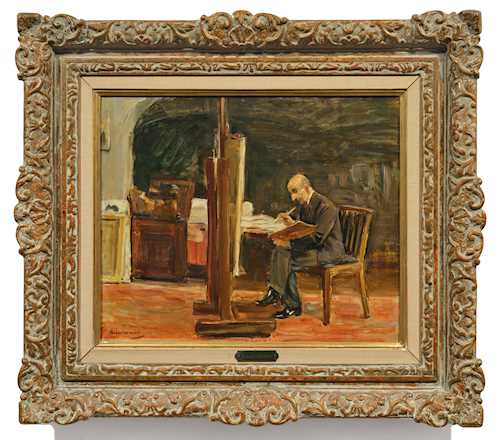
Lot 3208 - A209 Impressionist & Modern Art - Friday, 21. June 2024, 05.00 PM
MAX LIEBERMANN
(1847 Berlin 1935)
Self portrait: full length, seated facing left before the easel. Circa 1931.
Oil on canvas.
Signed lower left: M. Liebermann.
39 × 46 cm.
Provenance:
Our thanks to Magreet Nouwen for confirming the authenticity of this work, March 2024.
Max Liebermann was already 55 years old when he painted his first self-portrait. He created it in 1902/3, not out of the need to explore his own self, for he was already a respected artist and successful portraitist, but because the Uffizi Gallery in Florence asked to have one for their collection. The importance of the self-portrait within his Œuvre in the following years is shown by the large number of them – around 70 works – that he created by the end of his life. The images bear witness to a questioning of the self with impressive artistry.
In contrast to the predominantly representative self-portraits with and without painting utensils, here he shows himself at work situated in his studio. In a genre-like, almost intimate scene, Liebermann sits at the easel in his studio on Pariser Platz in Berlin, completely absorbed in his work. The center of the composition is not himself as a half- or three-quarter length figure, or the virtuosity and mastery of the works he is currently creating, but rather the moment of choosing the color before he puts his brush on the canvas. What he depicts is, so to speak, the intellectual moment before the idea takes shape on the canvas. Nothing distracts from this moment. His posture, with legs crossed and gaze lowered to the palette, shows the artist composed. The other pictures are turned towards the wall, the easel with the new canvas vertically dominant, but facing away from the viewer, in the center. The color composition also seems to emphasize this concentrated act of creation. The coloring takes a back seat, as so often happens in his later works, to the uniformity of the overall effect. Not only the muted colors and dominant light-dark contrast evoke a sense of inner calm, but especially Liebermann's bright head against a dark background. The otherwise airy, light, impressionistic brushstroke is seen only in the light red carpet; the rest of the image is dominated by a very concentrated brushstroke.
The importance of the moment captured here for Max Liebermann is also seen in the second variant that he made of this subject. However, the unemotional simplicity with which Max Liebermann emphasizes the intellectual act of artistic creation in our picture is exemplary.
Max Liebermann was already 55 years old when he painted his first self-portrait. He created it in 1902/3, not out of the need to explore his own self, for he was already a respected artist and successful portraitist, but because the Uffizi Gallery in Florence asked to have one for their collection. The importance of the self-portrait within his Œuvre in the following years is shown by the large number of them – around 70 works – that he created by the end of his life. The images bear witness to a questioning of the self with impressive artistry.
In contrast to the predominantly representative self-portraits with and without painting utensils, here he shows himself at work situated in his studio. In a genre-like, almost intimate scene, Liebermann sits at the easel in his studio on Pariser Platz in Berlin, completely absorbed in his work. The center of the composition is not himself as a half- or three-quarter length figure, or the virtuosity and mastery of the works he is currently creating, but rather the moment of choosing the color before he puts his brush on the canvas. What he depicts is, so to speak, the intellectual moment before the idea takes shape on the canvas. Nothing distracts from this moment. His posture, with legs crossed and gaze lowered to the palette, shows the artist composed. The other pictures are turned towards the wall, the easel with the new canvas vertically dominant, but facing away from the viewer, in the center. The color composition also seems to emphasize this concentrated act of creation. The coloring takes a back seat, as so often happens in his later works, to the uniformity of the overall effect. Not only the muted colors and dominant light-dark contrast evoke a sense of inner calm, but especially Liebermann's bright head against a dark background. The otherwise airy, light, impressionistic brushstroke is seen only in the light red carpet; the rest of the image is dominated by a very concentrated brushstroke.
The importance of the moment captured here for Max Liebermann is also seen in the second variant that he made of this subject. However, the unemotional simplicity with which Max Liebermann emphasizes the intellectual act of artistic creation in our picture is exemplary.
CHF 40 000 / 60 000 | (€ 41 240 / 61 860)
Sold for CHF 43 750 (including buyer’s premium)
All information is subject to change.


